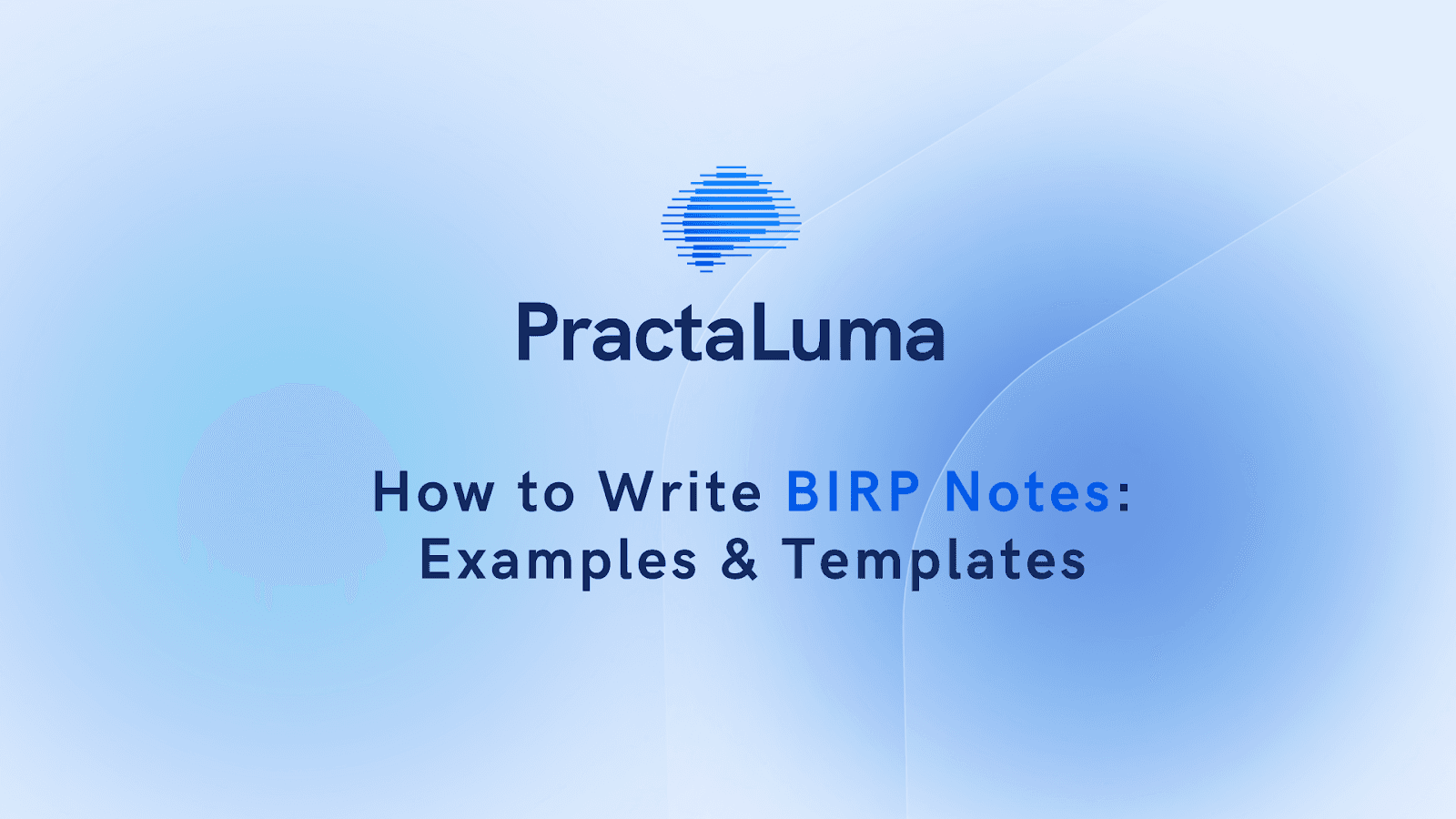
5 May 2025
How to Write BIRP Notes: Examples and Templates
Do your therapy notes need to be more organised and include key points?
BIRP notes are the solution. This structured format keeps your session documentation clear, organised, and efficient—without the headache. In this guide, we’ll break down how to write BIRP progress notes step-by-step, with examples and templates to simplify your note-taking and make it more compliant.
What are BIRP Notes: Definition and Purpose
If you are a healthcare practitioner, you already know how accuracy and consistency in documentation are essential.
That’s where BIRP progress notes come in—a clear, structured way to capture patient interactions, progress, and treatment plans. Used widely by therapists, counsellors, and healthcare professionals, BIRP notes help organise information so you can focus on providing the best care. Examples of BIRP progress notes show how these structured notes improve clarity and continuity.
BIRP stands for:
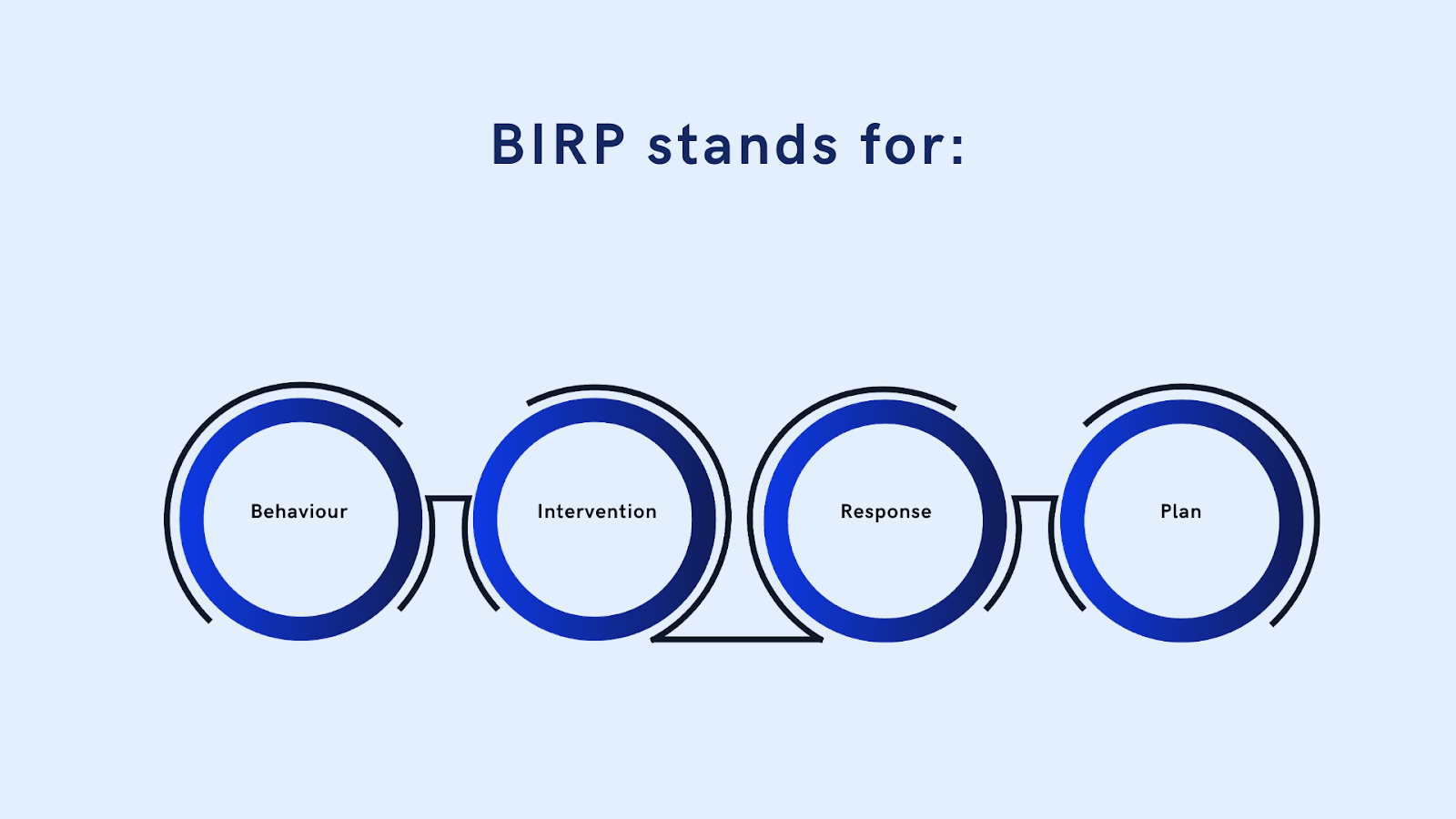
- Behaviour: Record the patient's actions, moods, or specific statements during a session.
- Intervention: Note the techniques or approaches you used to address the patient’s behaviour.
- Response: Describe how the patient reacted to your intervention.
- Plan: Outline the next steps or any goals for the patient to work on.
This simple format ensures your notes are thorough and easy for other professionals to understand if they need to review the case. Using BIRP notes effectively can streamline your work and improve communication across care teams.
Are you curious to try BRIP notes? Try it with Practaluma here.
A Detailed Guide to Writing BIRP Notes: Step-by-Step Insights
Creating practical BIRP notes can significantly enhance patient care by organising critical session details in a clear and actionable way. Whether you’re a counsellor, psychologist, or healthcare professional, following the BIRP structure—Behaviour, Intervention, Response, Plan—provides a reliable framework to document sessions. Here’s a breakdown of each section with practical tips and examples of BIRP progress notes to help you write effective BIRP notes.
1. Behaviour: Techniques for Describing Patient Observations
Behaviour is the first part of BIRP notes and focuses on objectively recording what you observe about the patient during the session. This can include physical behaviours, emotional expressions, and statements the patient makes.
Here are tips for capturing patient Behaviour accurately:
- Use Clear, Descriptive Language: Instead of vague terms like "appeared anxious," write observations like, “the patient sat with hands clasped tightly, frequently glancing at the door.”
- Focus on Both Verbal and Non-Verbal Cues: Body language, tone of voice, and facial expressions often provide deeper insights. For example, note if the patient speaks softly or avoids eye contact.
- Avoid Assumptions: Instead of interpreting emotions or intentions (e.g., "the patient seemed bored," "the patient checks their phone often", etc.), stay factual with phrases like, “The patient frequently checked their phone and yawned.”
By grounding your observations in clear, factual language, you avoid subjective biases and set a strong foundation for understanding patient progress. Below is a quick reference table to illustrate common behaviour descriptions and how to refine them.
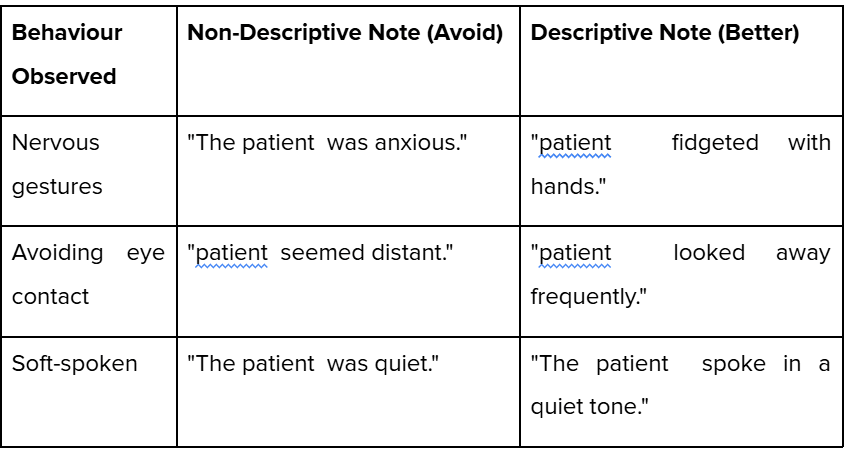
Pro Tip: Using specific language in this section allows other practitioners or future readers to understand precisely what behaviours were observed, supporting continuity in patient care.
2. Intervention: Documenting Techniques and Approaches Used
The Intervention section is where you outline the specific therapeutic techniques or approaches used during the session. This part is essential for tracking what methods are applied, how they’re adjusted, and whether they effectively address the patient’s needs.
Here’s how to document interventions effectively:
- Be Precise with Techniques: Specify the techniques or methods you used, such as “guided breathing exercises,” “cognitive restructuring,” or “motivational interviewing.”
- Explain the Rationale: Briefly note why the technique was chosen. For instance, you could write, “Introduced mindfulness exercises to help patients manage immediate stress.”
- Record Any Adjustments: Document these changes if you adjusted an intervention based on the patient’s needs. For example, “Shifted from guided breathing to visualisation when a patient expressed discomfort with deep breathing.”
Well-documented interventions offer clarity, ensuring your notes reflect what was tried and why. Make it easier for you and your care team to assess the effectiveness of various treatment approaches with Practaluma ’s comprehensive documentation tool.
3. Response: Analysing and Recording Patient Reactions
The Response section focuses on how the patient reacted to the interventions during the session. This part reveals which techniques are practical and how the patient is processing or responding to therapeutic work.
Here are ways to make the Response section clear and insightful:
- Document Immediate Reactions: Describe any immediate changes you observe. For example, “patients appeared more relaxed after practising guided breathing exercises”
- Include patient Feedback: Record specific comments from the patient, such as “I feel less tense” or “This helps me stay calm.” Direct feedback captures the patient’s perspective and adds depth to the notes.
- Remain Objective: Keep observations factual and avoid over-analysis. For instance, say, “Patient began speaking with more confidence,” rather than “Patient was more engaged.”
By recording responses precisely, you create a proper record to help identify what’s working well and guide future sessions and interventions.
4. Plan: Outlining Next Steps and Treatment Plan Adjustments
The Plan section is the final part of a BIRP note. It outlines actionable steps for the patient and goals for future sessions. This section ensures continuity by setting clear expectations for both you and the patient.
Here’s how to create an actionable plan:
List Specific Next Steps: Outline any assignments or practices for the patient, such as “Practice breathing exercises daily” or “Reflect on stress triggers in a journal.”
Set Short-Term Goals: To help maintain progress and motivation, mention objectives for the next session, like “Review effectiveness of CBT techniques."
Plan for Follow-Ups: Note any interventions to revisit or assess, such as “Evaluate response to mindfulness techniques in the next session.”
A detailed Plan keeps the patient engaged and focused, providing a roadmap for their therapeutic journey. This clarity also supports collaboration if multiple professionals are involved in the patient’s care.
Why BIRP Notes Matter: Key Benefits and Use Cases
Practical BIRP notes offer several benefits in mental health documentation:
- Consistency in Records: A structured approach ensures that all critical aspects are recorded.
- Clear Communication: BIRP notes provide a common framework, making it easier for other professionals to review and understand patient history.
- Patient Progress Tracking: By following a consistent format, BIRP notes help track progress and identify trends over time, which is invaluable for long-term care.
- Saves Time: By following a set format, you spend less time figuring out what to include and more time on patient care.
- Ensures Clarity: Each section (Behaviour, Intervention, Response, Plan) highlights specific session parts, making it easy to review and understand.
- Supports Collaboration: A standardised format allows other professionals involved in patient care to grasp session details quickly, improving teamwork and continuity of care.
Streamline your documentation process with Practaluma’s BIRP notes solutions, designed to make record-keeping more manageable and efficient for healthcare professionals. Learn more here.
BIRP Progress Notes Example
This example template uses the BIRP format and offers a clear framework for documenting client interactions. By breaking down sessions into Behavior, Intervention, Response, and Plan, the template supports thorough, organised notes that enhance continuity of care and streamline progress tracking.
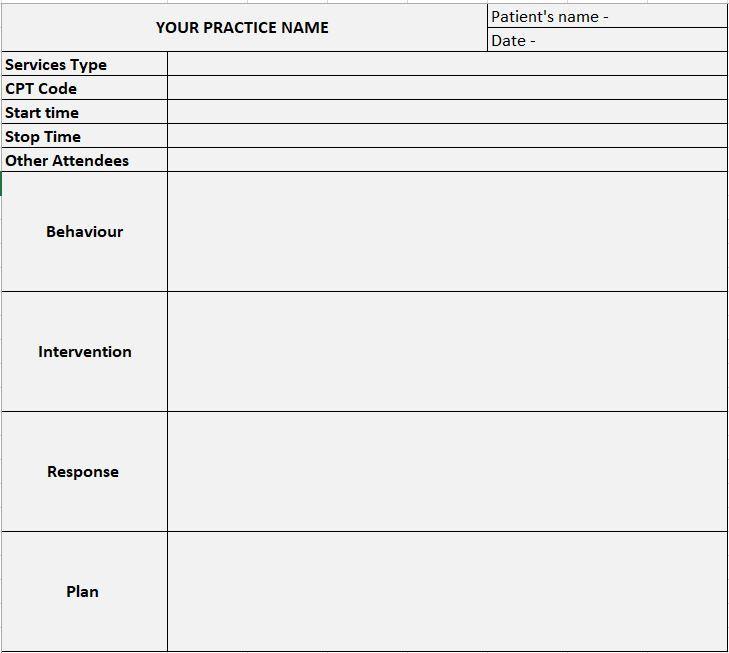
Quick Reference Table for BIRP Note Sections
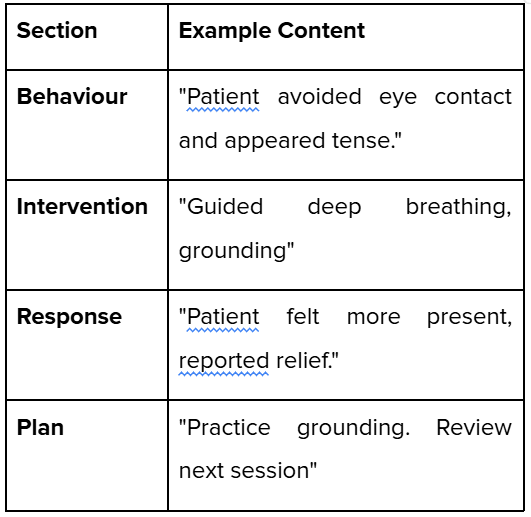
Anxiety Management: Techniques and Patient Feedback in BIRP Notes
Struggling with anxiety is one of the most common and documented effective techniques. In this case, patient feedback can make a real difference in treatment outcomes. For mental health professionals, BIRP notes offer a structured way to track anxiety management, capturing crucial details about what works for each individual.
Here’s how BIRP notes for anxiety management might look:
- Behaviour: Document the patient’s anxiety symptoms or triggers during the session, such as restlessness, avoidance, or racing thoughts.
- Intervention: Note the techniques introduced to manage anxiety, like deep breathing, grounding exercises, or cognitive reframing.
- Response: Record how the patient reacted to the intervention, including any changes in their anxiety levels or physical symptoms.
- Plan: Outline the following steps: practising specific techniques between sessions or setting small, manageable goals.
Using these elements, BIRP notes provide clear and actionable documentation that helps mental health professionals tailor strategies over time. Are you interested in seeing how BIRP notes apply to other mental health scenarios? Keep reading to explore more examples of depression and substance abuse recovery.
BIRP vs. SOAP vs. DAP Notes
Building on the importance of clear, structured documentation, it's essential to understand the differences between BIRP, SOAP, and DAP notes.
Each format offers a distinct approach to capturing session details: BIRP centres on behaviour and intervention, SOAP provides a thorough breakdown of subjective and objective data, and DAP offers a streamlined, data-focused summary.
By exploring these formats, professionals can choose the best fit for their documentation needs, supporting client care and effective record-keeping.
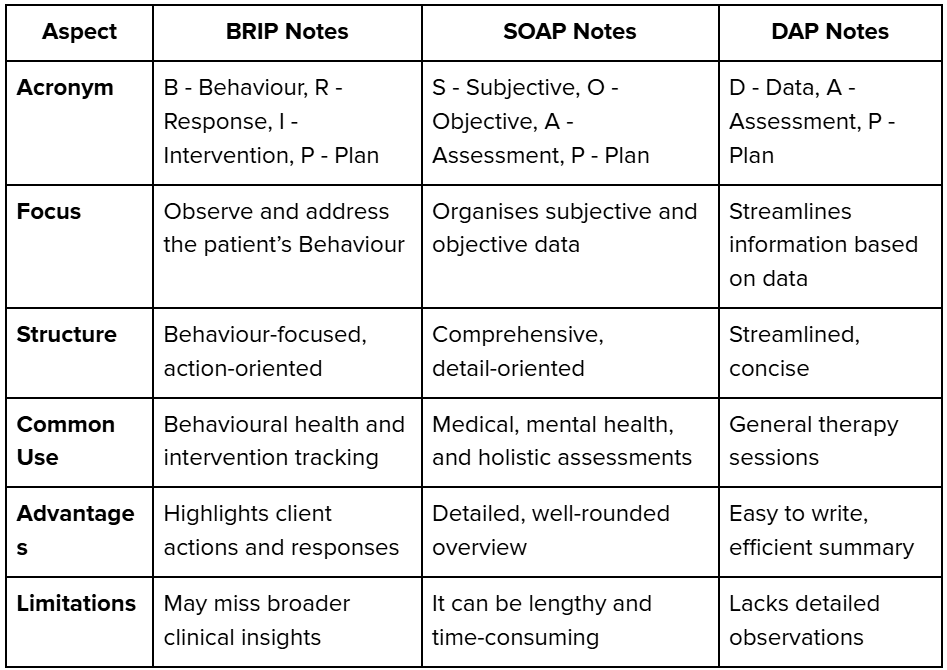
Avoiding Inconsistencies and Vagueness in BIRP Notes
Writing BIRP notes might seem straightforward, but it’s easy to fall into the trap of vague or inconsistent entries, which can impact the quality of care your patients receive. Inconsistent notes can lead to confusion, miscommunication, and missed progress updates—especially when multiple professionals are involved in a patient’s treatment.
To ensure clear, consistent BIRP notes:
- Be Specific: Describe symptoms and Behaviours specifically rather than using broad terms like 'painful' or 'improving.' For instance, instead of writing 'patient appeared to be in pain,' say 'patient reported discomfort, frequently rubbing their lower back and wincing when attempting to stand.’
- Stick to a Structure: To maintain clarity, consistently follow the BIRP format (Behaviour, Intervention, Response, Plan) in every note. Avoid skipping sections or overloading any single part with details.
- Review Regularly: Periodically check your notes for clarity and consistency. This helps prevent gaps or vague descriptions that could hinder future treatment decisions.
A transparent, structured approach to BIRP notes makes documentation easier and supports better patient outcomes. Ready to tackle the next challenge? In the following section, we’ll explore keeping treatment plans up-to-date.
Using Templates and Automated Tools for Quick Documentation
Writing BIRP notes can be time-consuming, especially when juggling multiple patients. Thankfully, templates and automated tools can make the process smoother and faster, ensuring you capture all necessary information without missing a beat.
Here’s how templates and automation can help:
- Pre-Formatted Templates: Many BIRP templates provide a clear structure for each section (Behaviour, Intervention, Response, Plan), allowing you to quickly fill in details without reinventing the wheel each time.
- Automated Documentation Tools: Tools like EHR software with built-in note-taking capabilities can speed things up by offering prompts, text suggestions, and even voice-to-text features. Practaluma offers the best Documentation tool. Talk to us here!
- Customisable Options: Look for templates you can customise to fit your practice style and patient needs. Adjusting a template to match your workflow can save time while maintaining a personal touch.
These resources can save you valuable time, helping you focus more on patient care and less on paperwork.
Practaluma ’s advanced documentation tools are designed to streamline your note-taking process, saving you time and ensuring accuracy. Discover how Practaluma can transform your mental health documentation today!
To learn more about BIRP Progress Notes, click on the video link below.

Source: Maelisa McCaffrey (QA Prep)
Conclusion
Using BIRP notes isn’t just about keeping organised records; it’s a powerful way to enhance the quality of care you provide. Examples of BIRP progress notes illustrate how structured documentation can support patient journeys and care adjustments.
BIRP notes are valuable in any clinical setting, whether in private practice, hospitals, or community centres. Are you ready to streamline your documentation with Practaluma?